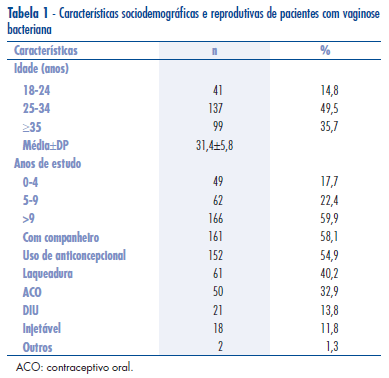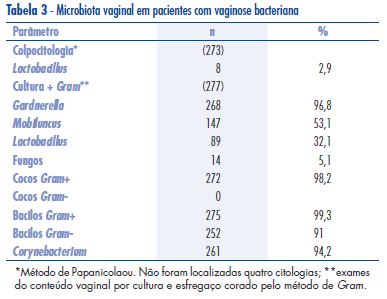PURPOSE: to study the clinical and microbiological profile of women with bacterial vaginosis participating in a randomized, double-blind clinical trial, which compared the vaginal use of preparations from red pepper tree and metronidazole for the treatment of genital discharge. METHODS: the study was conducted on a series of 277 women with bacterial vaginosis concomitantly diagnosed by the criteria of Amsel and Nugent, selected from a total of 462 recruited patients using the information obtained before intervention. Data were analyzed with the Epi-Info 3.32 software. In order to compare the outcomes frequencies between the intervention groups, the χ2 test was used and the risk ratio and 95% confidence interval were calculated. The intention to treat analysis was performed. In addition to the determination of diagnostic parameters, the culture of vaginal content and a Papanicolaou cytology test were also performed. RESULTS: the most frequent clinical complaints were genital discharge, observed in 206 participants (74.4%) and the fish odor of the vaginal secretion, which occurred in 68.6% of the cases (190 patients). Among the diagnostic clinical criteria, the presence of clue-cells was positive in 275 women (99.3%), the Whiff test, in 266 (96.0%), followed by pH >4.5, which occurred in 92.8% of the cases, and by the presence of fluid grayish discharge reported by 206 participants (74.4%). Regarding the Nugent criterion, the median score was 8.0. Culture of the vaginal content permitted the identification of Gardnerella vaginalis in 96.8% of cases and of Mobiluncus in 53.1%. Only one third of the exams showed the presence of Lactobacillus (89 women - 32.1%). Fungal growth occurred in the cultures of 14 participants (5.1%). In most cases, culture revealed the presence of Corynebacterium (94.2%), Gram-positive cocci (98.2%), as well as Gram-positive (99.3%) and Gram-negative (91.0%) bacilli. Oncotic colposcopy revealed a very scarce presence of lactobacilli, which were present in only 8 cytological exams (2.9%) out of the total of 273 exams performed. CONCLUSIONS: the results of the present study did not differ from the literature regarding the symptoms reported by the women, the clinical criteria most frequently observed in the diagnosis, or the bacterial species detected in cultures of vaginal content. These findings indicate the need for further studies that might better elucidate the interrelations between the microbiological findings and the clinical expression of bacterial vaginosis.
Vaginosis, bacterial; Gardnerella vaginalis; Mobiluncus;Lactobacillus; Bacterial infections; Vagina; Metronidazole; Anacardiaceae



